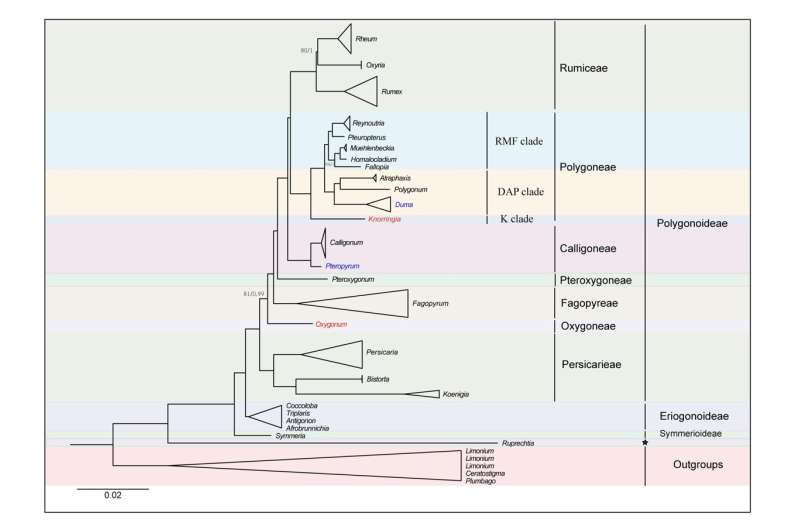This article has been reviewed according to Science X's editorial process and policies. Editors have highlighted the following attributes while ensuring the content's credibility:
fact-checked
peer-reviewed publication
trusted source
proofread
Researchers explore origin, dispersal and diversification of subfamily Polygonoideae

Polygonoideae comprises approximately 20 genera, which has a complex taxonomic history, although a few studies using plastid or nuclear DNA fragments have explored relationships within this family, intrafamilial relationships remain controversial. A comprehensive analysis, including plastome structure, phylogenomics and biogeography of Polygonoideae is lacking.
Polygonoideae has a worldwide distribution, covering North America, South America, Europe, Asia, Africa and Oceania, displaying intercontinental disjunction. However, studies investigating the area of origin and dispersal of the subfamily don't exist, thus limiting a comprehensive understanding of the evolutionary history of Polygonoideae.
Researchers from the Plant Phylogeny and Evolution Research Group at the Wuhan Botanical Garden of the Chinese Academy of Sciences (CAS) have newly assembled 17 plastomes representing 12 genera within Polygonaceae to explore phylogenetic relationships and trace the origins of Polygonoideae along with previously published plastome sequences.
The researchers explored both plastome phylogenomic and biogeographic analyses of the Polygonoideae. High conservation was revealed through plastome comparisons.
The phylogenomic analyses revealed seven lineages corresponding to seven tribes in Polygonoideae, with Persicarieae representing the earliest-diverging lineage. The biogeographic analyses indicated Polygonoideae originated in Asia during the Paleocene, following diversification via long-distance dispersal and vicariance mainly after the Eocene.
Both ancient vicariance and long-distance events have played important roles in shaping the current distribution pattern of Polygonoideae, according to the researchers.
This study provides insights into the comprehensive understanding of the evolution, including origin, dispersal and diversification of Polygonoideae. It also provides a good example for further study to investigate the evolution pattern of intercontinental disjunctions in a broader phylogenetic framework on a global scale.
Results were published in Frontiers in Plant Science, titled "Plastome phylogenomics and biogeography of the subfam. Polygonoideae (Polygonaceae)."
More information: Huajie Zhang et al, Plastome phylogenomics and biogeography of the subfam. Polygonoideae (Polygonaceae), Frontiers in Plant Science (2022). DOI: 10.3389/fpls.2022.893201
Journal information: Frontiers in Plant Science
Provided by Chinese Academy of Sciences



















